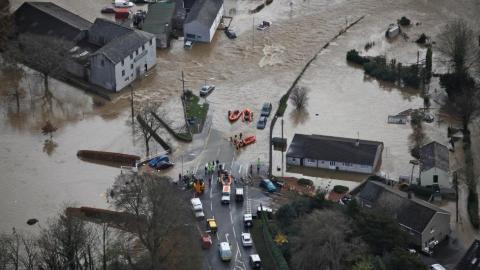Surface water flooding, “the biggest flood risk of all in the UK” according to the Environment Agency (2018), affects the operation of emergency responders who have to operate under flood conditions, while meeting their mandatory response time target. The operational decision making of emergency responders often involve determining when and where to allocate resources (e.g. closing flooded roads; pumping road sections to allow access; dispatching sandbags; positioning emergency vehicles; arranging cross-boundary and multi-agency operations). However, current system for forecasting surface water flooding is not designed for operational purpose. The proposed project aims to address two key research questions in order to unlock the potential of surface water flood forecasting for emergency services to support their operational decision making in a changing climate. These include: (i) uncertainty propagation from precipitation nowcasting and forecasting products to high-resolution surface water flood predictions; and (ii) effective communication of complex surface water flood risk information to support emergency responders’ operational decision making. In the UK, Fire & Rescue Services is one of the primary emergency responders to flood events, during which demands for services often peak. In this project, we will work together with London Fire Brigade, Cabinet Office and Met Office to address the two research questions.
The operational decision making of emergency responders often involve determining when and where to allocate resources. However, current system for predicting surface water flooding is not designed for operational purpose. The only (based on our knowledge) system exists is the UK Flood Forecast Centre’s daily service, which provides 5-day outlook of flood risks including surface water flooding. A flood guidance document is issued daily and surface water flood risk is provided at the county-level, based on a library of impact scenarios, rather than real-time analysis of risks. The spatial resolution and temporal frequency of the existing system means that such detailed decisions cannot be supported. Fundamentally, episodes of surface water flooding are typically less than 2-3 hours in the UK and associated with convective weather systems. Daily forecasts of surface water flooding are not able to capture the spatiotemporal dynamics of the fast-developing convective storms associated with such events. We developed the first nowcasting technology for surface water flooding using the latest weather forecast from the Met Office and capturing every short duration intense rainfall events that cause flooding. The proposed project aims to address two key research questions: (i) uncertainty propagation from precipitation nowcasting and forecasting products to high-resolution surface water flood predictions; and (ii) effective communication of complex surface water flood risk information to support emergency responders’ operational decision making.
Publications
- , . 2020. From flooding to finance: NHS ambulance-assisted evacuations of care home residents in Norfolk and Suffolk, UK. J Flood Risk Management. 13:e12592
- Yu, D., Yin, J., Wilby, R.L. et al. 2021. Disruption of emergency response to vulnerable populations during floods. Nat Sustain 3, 728–736
Image: Emergency responders have difficulty in reaching vulnerable populations during flooding.
Image credit: Cumbria flooding 2009, Environment Agency

